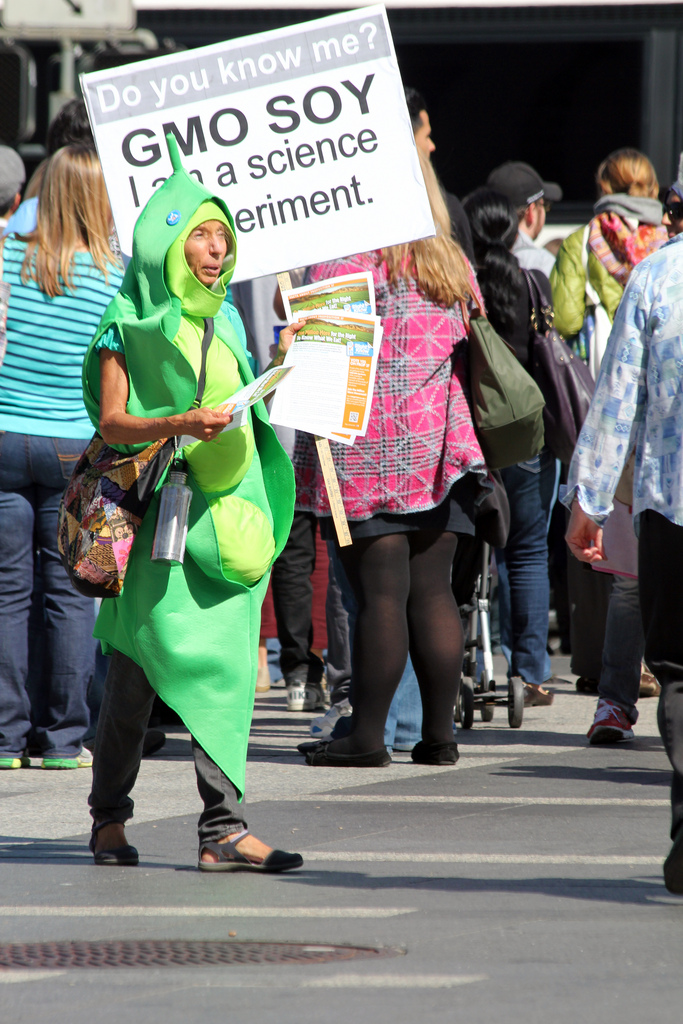
An anti-GMO protester dressed as a giant soy bean. Prop 37 has sparked major debates and protests throughout California over the labeling of genetically modified foods.
On Tuesday we Californians will vote on Prop 37 to decide whether or not to force companies to label their genetically modified foods. The European Union already requires the labeling of these GMOs, and some European countries ban genetically modified products outright. This labeling paints the picture that GMOs are dangerous and shouldn’t be developed let alone eaten.
Being from Santa Cruz I’ve seen crowds of protesters, signs in hand, covering seemingly every square foot of sidewalk in town to make sure everyone knows the sins of GMOs. Some of their signs read:
“Keep your GREED out of our GREENS”
“Keep our food safe! Stop GMOs!
“Defend yourself against genetic biohazards!”
“Genetically modified foods are poison”
“GMOs eat all the M&Ms out of your trail mix!”
All right, I might have made that last one up. The point is, if feeding rat poison to your kids is better than giving them a genetically modified carrot, why do we have these things in the first place? That’s what I’m here to discuss—how GMOs can do this world a lot of good.
I’m not going to be discussing whether GMOs are safe to eat (spoiler: they probably are) or if patenting life is acceptable, or even if we should force companies to label their genetically modified products (even though pretty much all GMO-free products are self-labeling). This post is just about the benefits GMOs bring to the table.

An African woman peeling cassavas. Cassavas are a major food staple for hundreds of millions of people around the world and are particularly drought resistant.
When we humans got over our awkward “hunter-gatherer” phase and started planting crops about 10,000 years ago, we started breeding plants for desirable traits, such as bigger harvests, easier harvesting and disease resistance. While farmers didn’t know it at the time, this selective breeding was altering the genetic makeup of the plants.
Jump forward to 1982 when the first deliberately genetically modified plant was grown (it was tobacco). Scientists could now tweak the genetic code of the plants directly – adding or subtracting sections of DNA – to create new plants with traits that are difficult or even impossible to get through conventional breeding. These added traits include herbicide resistance, uniformity, pest resistance and, perhaps most important, added nutritional content like Vitamin A, iron and protein.
These nutrients are important because drought-resistant crops don’t always offer the basic nutrition needed for a healthy diet. In many parts of the world, what’s affordable and available isn’t always nutritious. Cassavas – a South American root exported to drought-ridden areas like sub-Saharan Africa – provide a basic diet for three quarters of a billion people around the world, but don’t contain varied enough nutrition for a balanced diet. BioCassava Plus is a project to bioengineer a variety of fortified cassavas to fight malnutrition in some of the world’s most arid countries. Nutritional deficiencies make up 7 percent of deaths in low-income countries. While creating the nourishing cassavas is just first step in a long road to world-wide distribution, the team predicts it will have the proper approvals by 2017.
To say that GMOs are exclusively the dangerous products of corporate greed isn’t true. Genetically modified crops offer a solution to a global human issue. GMOs can help save lives, and that’s worth talking about.
BioCassava Plus: A collaborative research program that aims to reduce malnutrition in Africa
Uploaded by DanforthPlantScience on 2011-04-06.
Reblogged this on CRYING DISEASES!!!CRYING GERMS!!CRYING VIRUSES!!.
This is a very important point to make. GMOs are more than just RoundUp Ready corn in the midwest. I also like the point that humans have been fiddling with plants’ genetics for a long time.
I’m tempted to start a lawsuit if Prop 37 passes banning seedless grapes from being marketed as “Organic” — after all, grapes aren’t naturally seedless and it was only through genetic manipulation we have seedless grapes now.
Timely post, Thomas. Might be worth a follow-up next week. Prop 37 probably will get an 85% “Yes” vote in Santa Cruz County, which is one of the most anti-science places in the state (see: fluoridation, apple moths, vaccinations, astrology, homeopathic “medicine,” you name it). We’ll see how it fares elsewhere. Interesting that most of the state’s major papers have editorialized against it.
Well, it failed statewide. Reason prevails. Here in groovy Santa Cruz County, it passed with 65.6% of the vote, so I was a bit off in my projection.